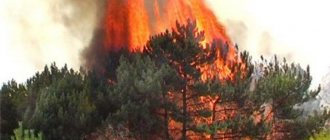Home page Natural phenomena
13 302 3.83 1
One of the most terrible avalanches in the history of mankind came down from Mount Huascaran (Peru) about half a century ago: after an earthquake, a huge mass of snow fell from its slopes and rushed down at a speed exceeding three hundred kilometers per hour. Along the way, it broke off part of the underlying glacier, and also carried sand, rubble, and blocks with it.
In the path of the snow flow there was also a lake, the water from which, after a tremendous force of impact, splashed out and, adding water to the rushing mass, formed a mudflow. The avalanche stopped only after it had covered a distance of seventeen kilometers and completely demolished the village of Ranairka and the city of Yungai, killing about twenty thousand people: only a few hundred local residents managed to escape.
Deadly snow cloud
An avalanche is formed by snow, ice and rocks after they begin to slide down steep mountain slopes at an ever-increasing speed (from 20 to 1000 m/s), capturing new portions of snow and ice, increasing their volume. Considering that the impact force of the elements often amounts to tens of tons per square meter, an avalanche sweeps away everything in its path. It stops only at the bottom, having reached gentle sections of the slope or finding itself at the bottom of the valley.
Avalanches form only in those parts of the mountain where there are no forests, the trees of which could slow down and prevent the snow from gaining the required speed.
The snow cover begins to move after the thickness of the freshly fallen snow begins to be at least thirty centimeters (or the layer of old snow exceeds seventy), and the steepness of the mountain slope ranges from fifteen to forty-five degrees. If the layer of fresh snow is about half a meter, the probability of snow melting in 10-12 hours is incredibly high.
Secrets of the Bermuda Triangle69494.3993
It is impossible not to mention the role of old snow in the formation of avalanches in the mountains. It forms an underlying surface that allows freshly fallen precipitation to slide over it unhindered: old snow fills all the unevenness of the soil, bends bushes to the ground, forming a perfectly smooth surface (the larger its layer, the fewer rough obstacles that can stop the snow from falling).
The most dangerous periods when snow falls occur are considered to be winter and spring (about 95% of cases are recorded at this time). A snowfall is possible at any time of the day, but more often this event occurs during the day. The occurrence of landslides and avalanches is primarily influenced by:
- Snowfall or concentration of huge amounts of snow on mountain slopes;
- Weak adhesive force between new snow and the underlying surface;
- Warming and rain, resulting in the formation of a slippery layer between snow precipitation and the underlying surface;
- Earthquakes;
- A sudden change in temperature (sharp cooling after unexpected warming, which makes it possible for fresh snow to slide comfortably over the formed ice);
- Acoustic, mechanical and wind effects (sometimes a scream or clap is enough to set the snow in motion).
Sweeping everything out of the way
Freshly fallen snow precipitation is held on the slope due to the friction force, the magnitude of which depends primarily on the angle of the slope and the moisture content of the snow. A collapse begins when the pressure of the snow mass begins to exceed the force of friction, resulting in the snow coming into a state of unstable equilibrium.
As soon as the avalanche begins to move, a pre-avalanche air wave is formed, which clears the path for the avalanche, destroying buildings, filling up roads and paths.
Before a snowfall occurs, a dull sound is heard high in the mountains, after which a huge cloud of snow rushes down from the top at high speed, taking with it everything that comes in its way. It rushes without stopping, gradually picking up pace, and stops no sooner than it reaches the bottom of the valley. After this, a huge layer of snow dust shoots high into the sky, forming a continuous fog. When the snow dust falls, dense piles of snow open before your eyes, in the middle of which you can see branches, remains of trees, and boulders.
Where and how avalanches occur - five reasons
Every year in Europe, about 100 people die during avalanches. At the same time, many Alpine regions cannot imagine their existence without ski tourism. It is not surprising that at the initiative of such European countries as Austria and Germany, the European Avalanche Warning Services (EAWS) was founded. The purpose of this service is to prevent cases when an avalanche kills people or damages infrastructure.
The Avalanche Warning Service develops reference materials on avalanche safety, and also conducts ongoing work on monitoring, forecasting and preventing avalanches in Europe. If you're planning a trip to a European ski resort, this resource will provide up-to-date information about the risks and snow conditions in your location. Publications are provided in several European languages, but, unfortunately, not in Russian. In this article you will find a translation of a bulletin about the five causes of avalanches.
The five common avalanche problems identified by the European Avalanche Warning Service EAWS aim to describe typical situations encountered in avalanche terrain and to support avalanche specialists and outdoor enthusiasts in their assessment of avalanche danger. The description of each avalanche problem includes:
- General characteristics of the avalanche area
- Possible types of avalanche
- Description of a typical distribution site
- Description of the position of the weak layer* in the snow cover
- Characteristics of the avalanche mechanism
- Description of typical duration and periods of avalanches
- Tips for travelers in this area
*A weak layer is a layer of snow that can break/slide out of place, thereby starting an avalanche.
Typical avalanche problems approved by the EAWS General Assembly, Munich 2021
| What is this? | Characteristics | The avalanche problem is related to current or recent snowfall. The amount of additional load of new snow on the existing snowpack is the deciding factor for a new snow problem. How critical the load is depends on various factors, such as temperature or the characteristics of the old snowpack | |
| Possible type of avalanche | • Avalanches from snow-covered slabs • Dry loose snow avalanches • Avalanches caused by natural phenomena and people. | ||
| Where is it observed? | Spatial distribution | Typically present widely and frequently in all aspects | |
| Position of weak layers in the snow cover | Usually at the transition to the old snow surface, but sometimes in new layers of snow, and sometimes deeper in the old snow cover. | ||
| Why is this happening? | Characteristics of snow-slab avalanches: | Dry loose snow avalanches: • Additional load due to snowfall on existing or newly created weak layers of snow. | Dry snow avalanches: • Lack of cohesion between new snow particles. |
| When does it happen? | Duration | Usually during a snowfall and for several days after it. | |
| How to mitigate avalanche risks? | Identifying a problem on a slope | The problem associated with fresh snow is quite easy to recognize. Monitor the weather and forecast, as well as information about recent avalanche activity. Be aware of small weather changes (such as changes in air humidity) that affect new snow conditions. | |
| Travel tips | Dry, loose snow avalanches: wait until the snow cover stabilizes. | Dry snow avalanches: the danger is the risk of falling/falling through the snow. The risk of being covered by such an avalanche is much less. Take this into account on steep slopes. | |
| What is this? | Characteristics | The problem of an avalanche is related to snow brought by the wind. Snow can be carried by wind with or without simultaneous snowfall. |
| Possible type of avalanche | • Avalanches from snow-covered slabs • Avalanches caused by natural and anthropogenic factors | |
| Where is it observed? | Spatial distribution | Very variable, but usually downwind in ravines, hollows, near distinct changes in slope, behind ridge lines or other sheltered areas. More common above tree line. |
| Position of weak layers in the snow cover | Typically at the transition to the old snow surface or in the wind layer due to wind speed fluctuations and fluctuations during the storm cycle, but sometimes deeper into the old snowpack. | |
| Why is this happening? | Characteristics of snow-slab avalanches: | Wind-blown snow places additional stress on the weak layer and forms a slab that is particularly prone to supporting crack propagation |
| When does it happen? | Duration | Snow blown by the wind can develop very quickly. The problem usually persists during snow drift, up to a few days at most, depending on the development of the snow cover. |
| How to mitigate avalanche risks? | Identifying a problem on a slope | Sometimes, the risk of an avalanche can be recognized visually. Pay attention to wind direction indicators and look for fresh snow formations. Typical clues: new snow formations, recent avalanche activity, earthquakes. and sometimes cracks in the snow. |
| Travel tips | Avoid new-looking snow on steep slopes, especially in areas where the snow cover changes from thin to thick or hard to soft. | |
| What is this? | Characteristics | The avalanche problem is related to the presence of persistent weak layers in the old snow cover. These weak layers usually include hidden surface frost, deep frost, or faceted snow crystals |
| Possible type of avalanche | • Avalanches covered with dry snow • Avalanches mainly caused by humans; Natural avalanches are rare, mostly in combination with other avalanche problems. | |
| Where is it observed? | Spatial distribution | An avalanche problem can be widespread or completely isolated. It can exist in all aspects, but is more often found on shady, sheltered slopes. |
| Position of weak layers in the snow cover | Anywhere in old snowpack, often deep in snowpack. However, when deep, the avalanche becomes more and more difficult. | |
| Why is this happening? | Characteristics of snow-slab avalanches: | The avalanche under loading exceeds the strength of the weak layer |
| When does it happen? | Duration | Weak layers can persist for weeks to months; perhaps most of the winter season. |
| How to mitigate avalanche risks? | Identifying a problem on a slope | Persistent weak layers are very difficult to recognize. Signs of instability, such as swelling, are typical but not necessarily present. Stability tests can be useful in identifying persistent weak layers. Information on snowpack history is critical, as is a recently published avalanche report. Crack propagation over long distances is common and remote collapse is possible. |
| Travel tips | Travel carefully and avoid large steep inclines. Research the history of weather and snow cover in the area. Be especially careful in areas with thin snow cover and when transitioning from thin snow cover to deep snow cover. This problem is the leading cause of death due to avalanches while on vacation. | |
| What is this? | Characteristics | The avalanche problem is associated with weakening snow cover due to the presence of melted snow masses. Water penetrates into the snowpack due to melting snow or rain. | |
| Possible type of avalanche | • Avalanches from wet snow on slabs • Avalanches from wet, loose snow • Mostly natural avalanches | ||
| Where is it observed? | Spatial distribution | When sun is the main cause, the extent of the problem depends mainly on the slope and altitude. In the event of rain on snow, all slopes are affected. | |
| Position of weak layers in the snow cover | Anywhere in the snow | ||
| Why is this happening? | Characteristics of wet snow avalanches: | Avalanches of wet, loose snow: • Weakening of pre-existing weak layers in the snowpack or formation of accumulations at layer boundaries • If it rains, there is also additional stress on weak layers | Wet snow avalanches: Breakdown of adhesion between snow crystals |
| When does it happen? | Duration | • From hours to days • Possible rapid loss of stability • Natural avalanches may be more likely at certain times of the day, especially in the afternoon (unless rain is the dominant factor). | |
| How to mitigate avalanche risks? | Identifying a problem on a slope | A wet snow problem is usually easy to recognize. The onset of rain, snowballing, pin rolling and small wet slabs or loose wet avalanches are often the harbingers of natural avalanche activity on wet snow slabs. Another sign of increased hydration is deep penetration of the foot. | |
| If there is sunny weather, after cold nights, clear skies in the morning are usually favorable due to frost. After warm nights with cloudy skies, the problem often occurs in the morning. Usually rain on fresh snow creates this problem almost immediately. It is important to correctly calculate the time and plan the trip. Be aware of avalanche zones. | |||
| What is this? | Characteristics | The entire snowpack slides along the ground, usually on level surfaces such as grassy slopes or smooth areas of rock. High snow avalanche activity is usually associated with thick snow cover without layers or with several layers. Sliding snow avalanches can occur both with cold, dry snow cover and with warm, wet snow cover. An avalanche of sliding snow is difficult to predict, although sliding cracks usually open before the avalanche. |
| Possible type of avalanche | • Sliding snow avalanches; cold dry or 0° Cysothermic wet snow • Any avalanche is usually natural. Human and artificial triggers are unlikely. | |
| Where is it observed? | Spatial distribution | Predominant on flat surfaces and on any slopes, however, more often on southern slopes. |
| Position of weak layers in the snow cover | The interface between the ground and the snow cover. | |
| Why is this happening? | Characteristics of wet snow avalanches: | Sliding snow avalanche mechanisms arise from loss of friction at the snow-ground interface. |
| When does it happen? | Duration | From days to months; perhaps the entire winter season. The descent can occur at any time of the day. In spring, avalanches occur mainly in the afternoon. |
| How to mitigate avalanche risks? | Identifying a problem on a slope | If slip cracks are present, the problem can often be localized, but the presence of slip cracks does not indicate an imminent avalanche, as this is almost impossible to predict. It is also common for an avalanche to occur without pre-existing sliding cracks. |
| Travel tips | Avoid areas close to slip cracks. | |
We sincerely hope that this background information will contribute to your awareness of such a dangerous phenomenon as avalanches. We strongly recommend researching the potential avalanche risks at your vacation destination this winter. Whenever possible, try to find local resources on avalanche risks and never neglect safety tips.
Have a safe holiday!
Alexander
Hello, I'm Alexander, the mastermind behind the blog. In terms of career and free time, I connected my life with the forest. How could it be otherwise when you live in Karelia! In this blog, I am responsible for sections dedicated to hunting, hiking and equipment. Welcome to my world!
Video survival lessons for beginners
How dangerous are avalanches?
According to statistics, it is the collapse of snow that causes fifty percent of accidents in the mountains, and often causes the death of climbers, snowboarders, and skiers. An avalanche coming down can simply throw a person off the slope, which is why he can break during the fall, or cover him with such a thick layer of snow and cause death from cold and lack of oxygen.
A snowfall is dangerous because of its mass, often amounting to several hundred tons, and therefore, covering a person, often leads to suffocation or death from painful shock caused by broken bones. In order to warn people about the approaching danger, a special commission developed a system for classifying the risks of avalanches, the levels of which are indicated by flags and posted at ski resorts and resorts:
- The first level (minimum) - the snow is stable, so a collapse is possible only as a result of a strong impact on the snow masses on very steep slopes.
- Second level (limited) - the snow on most slopes is stable, but in some places it is a little unstable, but, as in the first case, large avalanches will occur only due to a strong impact on the snow masses;
- The third level (medium) - on steep slopes the layer of snow is weakly or moderately stable, and therefore an avalanche can form with little impact (sometimes an unexpected large snowfall is possible);
- Fourth (high) - the snow on almost all slopes is unstable and an avalanche occurs even with a very weak impact on the snow masses, while a large number of medium and large unexpected avalanches may occur.
- Level five (very high) – the likelihood of a huge number of large landslides and avalanches, even on non-steep slopes, is extremely high.
Landslides
Definition 2
A landslide is the movement of rocks under the influence of their own mass down a slope.
Are you an expert in this subject area? We invite you to become the author of the Directory Working Conditions
Landslides can form in various rocks. They are the result of an imbalance and a decrease in the strength of rocks. The causes of landslides can be both natural and artificial. Among natural causes, the most common are seismic tremors, eroding rocks by river or sea waters. Artificial or anthropogenic (caused by human activity) causes may be the destruction of slopes by road cutting, deforestation, excessive removal of soil, and others.
There are several ways to classify landslides:
- By type and condition of the substance (rock, sand, snow, stone, soil).
- According to the speed of movement (fast - from several seconds to several minutes, medium - up to several hours, slow - from several days to several years).
- By scale (large - up to hundreds of meters in area and 1 meter thick, medium, small-scale).
- By degree of activity (active and inactive).
- According to the degree of humidity (dry, slightly damp, damp, very damp).
- According to the place of formation (mountain, underwater, snow and landslides resulting from the construction of artificial earthen structures).
- By thickness (small, medium, large and very large, in which the volume of displaced rocks can be about one million square meters, and sometimes more).
Finished works on a similar topic
Course work Natural disasters: avalanches, mudflows, landslides 490 ₽ Abstract Natural disasters: avalanches, mudslides, landslides 230 ₽ Test work Natural disasters: avalanches, mudslides, landslides 190 ₽
Receive completed work or specialist advice on your educational project Find out the cost
Landslides are a very dangerous natural phenomenon that can destroy agricultural land, dams, entire settlements, create a danger during open-pit mining, and damage communications (tunnels, pipelines, power lines).
The largest landslide in the world is considered to be a landslide located in the USA, in the state of Wyoming, its area is 2000 square meters, and the speed reached 100 km/h. It came down from the slopes 30 million years ago. Of the modern ones, the most tragic is considered to be the landslide that occurred in China in 1920 and claimed the lives of 200,000 people.
There are two types of landslide prevention methods: active and passive.
Passive methods are preventive measures that prohibit: pruning landslide slopes, rows on slopes and cliffs, rapid traffic movement in a landslide zone, cutting down trees in a landslide zone, discharging water into a landslide zone.
Active measures - construction of support structures and consolidation of the landslide layer. Such measures are divided into 4 groups:
- combating processes that cause landslides;
- retention of sliding rocks;
- increasing the resistance of rocks to shear force;
- eating landslide masses.
Safety precautions
To avoid death and not to be buried under a thick layer of snow, every person going to the mountains on vacation while there is snow there must learn the basic rules of behavior when a deadly stream descends.
If an avalanche warning has been announced during your stay at the base, it is advisable to refrain from hiking in the mountains. If there was no warning, then before leaving the base and hitting the road, you need to take into account the forecast of the risk of snow melting, as well as find out as much as possible about the mountains in which the risk of avalanches is maximum and avoid dangerous slopes (this simple rule of behavior is quite capable of saving life).
If heavy snowfalls were recorded before going to the mountains, it is better to postpone the hike for two or three days and wait for the snow to fall, and if there are no avalanches, wait until it settles. It is also very important not to go to the mountains alone or together: it is advisable to stay in a group. This will always provide avalanche insurance, for example, if the group members are tied with avalanche tape, this will make it possible to detect a companion covered in snow.
Before going out into the mountains, it is advisable to take with you an avalanche transceiver, which will make it possible to find a person caught in an avalanche.
It is very important not to forget to take your mobile phone with you (it has already saved more than one person’s life). It is also a good idea to take special avalanche backpacks, which have a system of inflatable cushions that make it possible for a person caught in an avalanche to “float up”.
In the mountains you need to move only along roads and paved paths of valleys and along mountain ridges, and it is very important to remember that you cannot drive onto steep snow-covered slopes, cross them across them, or move in a zigzag. It is also forbidden to step on snow cornices, which are accumulations of dense snow in the form of a canopy on the leeward side of a sharp ridge (they may well collapse suddenly and cause an avalanche).
If it is not possible to go around a steep slope, before overcoming it, you need to make sure that the snow cover is stable. If it begins to sink under your feet and begins to make a hissing sound, you need to go back and look for another road: the likelihood of an avalanche is high.











